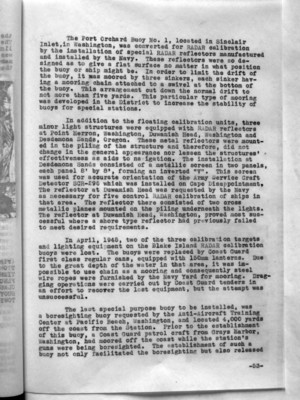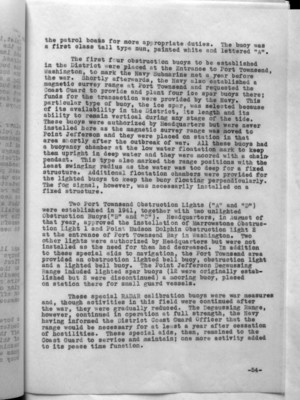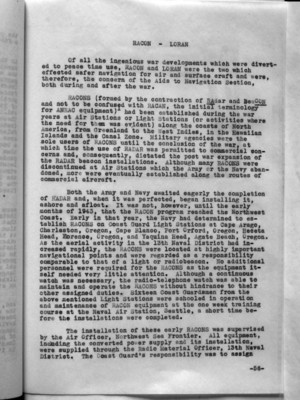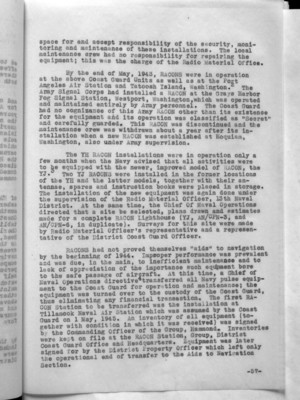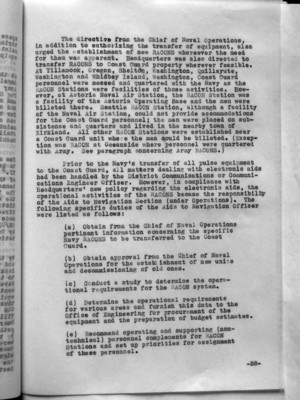Pages That Mention COAST GUARD
Coast Guard District narrative histories 1945
73
The Port Orchard Buoy No. 1, located in Sinclair Inlet, in Washington, was converted for RADAR calibration by the installation of special RADAR reflectors manufactured and installed by the Navy. These reflectors were so designed as to give a flat surface no matter in what position the buoy or ship might be. In order to limit the drift of the buoy, it was moored by three sinkers, each sinker having a mooring chain attached to a swivel at the bottom of the buoy. This arrangement cut down the normal drift to not more than five yards. This particular type of mooring was developed in the District to increase the stability of buoys for special stations.
In addition to the floating calibration units, three minor light structures were equipped with RADAR reflectors at Point Herron, Washington, Duwamish Head, Washington and Desdemona Sands, Oregon. These metal reflectors were mounted in the piling of the structure and therefore, did not change in the general appearance nor lessen the structures' effectiveness as aids to navigation. The installation at Desdemona Sands consisted of a metallic screen in two panels, each panel 8' by 8', forming an inverted "V". This screen was used for accurate orientation of the Army Service Craft Detector SCR-296 which was installed on Cape Disappointment. The reflector at Duwamish Head was requested by the Navy as necessary for five control RADAR calibration of ships in that area. The reflector there consisted of two cross metallic planes mounted on the piling underneath the lights. The reflector at Duwamish Head, Washington, proved most successful where a shore type reflector had previously failed to meet desired requirements.
In April, 1945, two of the three calibration targets and lighting equipment on the Blake Island RADAR calibration buoys were lost. The buoys were replaced by Coast Guard first class regular cans, equipped with 150mm lanterns. Due to the great depth of the water in that area, it was impossible to use chain as a mooring and consequently steel wire ropes were furnished by the Navy Yard for mooring. Dragging operations were carried out by Coast Guard tenders in an effort to recover the lost equipment, but the attempt was unsuccessful.
The last special purpose buoy to be installed, was a boresighting buoy requested by the Anti-Aircraft Training Center at Pacific Beach, Washington, and located 4,000 yards off the coast from the Station. Prior to the establishment of this buoy, a Coast Guard patrol craft from Grays Harbor, Washington, Had moored off the coast while the station's guns were being boresighted. The establishment of such a buoy not only facilitated the boresighting but also released
-53-
74
the patrol boats for more appropriate duties. The buoy was a first class tall type nun, painted white and lettered "A".
The first four obstruction buoys to be established in the District were placed at the Entrance to Port Townsend, Washington, to mark the Navy Submarine net a year before the war. Shortly afterwards, the Navy also established a magnetic survey range at Port Townsend and requested the Coast Guard to provide and plant four ice spar buoys there; funds for the transaction were provided by the Navy. This particular type of buoy, the ice spar, was selected because of its availability in the District, its length and its ability to remain vertical during any stage of the tide. These buoys were authorized by Headquarters but were never installed here as the magnetic survey range was moved to Point Jefferson and they were placed on station in that area shortly after the outbreak of the war. All these buoys had a buoyancy chamber at the low water flotation mark to keep them upright in deep water and they were moored with a chain pendant. This type also marked the range positions with the least swinging radius as the water was too deep for a fixed structure. Additional flotation chambers were provided for the lighted buoys to keep the buoy floating perpendicularly. The fog signal, however, was necessarily installed on a fixed structure.
Two Port Townsend Obstruction Lights ("A" and "D") were established in 1941, together with two unlighted Obstruction Buoys ("B" and "C"). Headquarters, in August of that year, approved the installation of Marrowstone Obstruction Light 1 and Point Hudson Dolphin Obstruction Light 2 at the entrance of Port Townsend Bay in Washington. Two other lights were authorized by Headquarters but were not installed as the need for them had decreased. In addition to these special aids to navigation, the Port Townsend area provided an obstruction lighted bell buoy, obstruction light and a lighted bell buoy. The Point Jefferson Degaussing Range included lighted spar buoys (12 were originally established but 2 were discontinued) a mooring buoy, placed on station there for small guard vessels.
These special RADAR calibration buoys were war measures and, though activities in this field were continued after the war, they were gradually reduced. The Degaussing Range, however, continued in operation at full strength, the Navy having informed the District Coast Guard Officer that the range would be necessary for at least a year after cessation of hostilities. These special aids, then, remained to the Coast Guard to service and maintain; one more activity added to its peace time function.
-54-
76
Of all the ingenious war developments which were diverted to peace time use, RACON and LORAN were the two which effected safer navigation for air and surface craft and were, therefore, the concern of the Aids to Navigation Section, both during and after the war.
RACONS (formed by the contraction of RAdar and BeaCON and not to be confused with RACAN, the initial terminology for ANRAC equipment)¹ had been established during the war years at Air Stations or Light Stations (or activities where the need for them was evident) along the coasts of North America, from Greenland to the West Indies, in the Hawaiian Islands and the Canal Zone. Military agencies were the sole users of RACONS until the conclusion of the war, at which time the use of RADAR was permitted to commercial concerns and, consequently, dictated the post war expansion of the RADAR beacon installations. Although many RACONS were discontinued at Air Stations which the Army or the Navy abandoned, more were eventually established along the routes of commercial aircraft.
Both the Army and Navy awaited eagerly the completion of RADAR and, when it was perfected, began installing it, ashore and afloat. It was not, however, until the early months of 1943, that the RACON program reached the Northwest Coast. Early in that year, the Navy had determined to establish RACONS on Coast Guard Light Stations at Cape Arago, Charleston, Oregon, Cape Blanco, Port Orford, Oregon, heceta Head, Florence, Oregon, and Yaquina Head, Agate Beach, Oregon. As the aerial activity in the 13th Naval District had increased rapidly, the RACONS were located at highly important navigational points and were regarded as a responsibility comparable to that of a light or radiobeacon. No additional personnel were required for the RACONS as the equipment itself needed very little attention. Although a continuous watch was necessary, the radio-telephone watch was able to maintain and operated the RACONS without hindrance to their other assigned duties. Sixteen Coast Guardsmen from the above mentioned Light Stations were schooled in operation and maintenance of RACON equipment at the one week training course at the Naval Air Station, Seattle, a short time before the installations were completed.
The installation of these early RACONS was supervised by the Air Officer, Northwest Sea Frontier. All equipment, including the converted power supply and its installation, were supplied through the Radio Material Officer, 13th Naval District. The Coast Guard's responsibility was to assign
-56-
77
space for and accept responsibility of the security, monitoring and maintenance of these installations. The local maintenance crew had no responsibility for repairing the equipment; this was the charge of the Radio Material Office.
By the end of May, 1943, RACONS were in operation at the above Coast Guard Units as well as at the Port Angeles Air Station and Tatoosh Island, Washington. The Army Signal Corps had installed a RACON at the Grays Harbor Fog Signal Station, Westport, Washington, which was operated and maintained entirely by Army personnel. The Coast Guard had no cognizance of this Army RACON other than its existence for the equipment and its operation was classified as "Secret" and carefully guarded. This RACON was discontinued and the maintenance crew was withdrawn about a year after its installation when a new RACON was established at Hoquiam, Washington, also under Army supervision.
The YH RACON installations were in operation only a few months when the Navy advised that all activities were to be equipped with the newer, improved model of RACON, the YJ.³ Two YJ RACONS were installed in the former locations of the YH and the latter models, together with their antennae, spares and instruction books were placed in storage. The installation of the new equipment was again done under the supervision of the Radio Material Officer, 13th Naval District. At the same time, the Chief Of Naval Operations directed that a site be selected, plans drawn and estimates made for a complete RACON Lighthouse (YJ, AN/CPN-3, and AN/CPN-6, in duplicate). Surveys for this site were made by Radio Material Officer's representative and a representative of the District Coast Guard Officer.
RACONS had not proved themselves "aids" to navigation by the beginning of 1944. Improper performance was prevalent and was due, in the main, to inefficient maintenance and to lack of appreciation of the importance such equipment bore to the safe passage of aircraft. At this time, a Chief of Naval Operations directive^4 transferred all Navy pulse equipment to the Coast Guard for operation and maintenance; the equipment was turned over to the custody of the Coast Guard, thus eliminating any financial transaction. The first RACON Station to be transferred was the installation at Tillamook Naval Air Station which was assumed by the Coast Guard on 1 May, 1945. An inventory of all equipment (together with condition in which it was received) was signed by the Commanding Officer of the Group, Hammond. Inventories were kept on file at the RACON Station, Group, District Coast Guard Office and Headquarters. Equipment was later signed for by the District Property Officer which left only the operational end of transfer to the Aids to Navigation Section.
-57-
78
The directive from the Chief of Naval Operations, in addition to authorizing the transfer of equipment, also urged the establishment of new RACONS wherever the need for them was apparent. Headquarters was also directed to transfer RACONS to Coast Guard property wherever feasible. At Tillamook, Oregon, Shelton, Washington, Coast Guard personnel were messed and quartered with the Navy as the RACON Stations were facilities of those activities. However, at Astoria Naval Air Station, the RACON Station was a facility of the Astoria Operating Base and the men were billeted there. Seattle RACON Station, although a facility of the Naval Air Station, could not provide accommodations for the Coast Guard personnel; the men were placed on subsistence and quarters and lived in the nearby town of Kirkland. All other RACON Stations were established near a Coast Guard unit where the men could be billeted. (Exception was RACON at Oceanside where personnel were quartered with Army. See paragraph concerning Army RACONS.)
Prior to the Navy's transfer of all pulse equipment to the Coast Guard, all matters dealing with electronic aids had been handled by the District Communications or Communications Engineer Officer. However, in compliance with Headquarters' new policy regarding the electronic aids, the operational activities of the RACONS became the responsibility of the Aids to Navigation Section (under Operations). The following specific duties of the Aids to Navigation Officer were listed as follows:
(a) Obtain from the Chief of Naval Operations pertinent information concerning the specific Navy RACONS to be transferred to the Coast Guard.
(b) Obtain approval form the Chief of Naval Operations for the establishment of new units and decommissioning of old ones.
(c) Conduct a study to determine the operational requirements for the RACON system.
(d) Determine the operational requirements for various areas and furnish this data to the Office of Engineering for procurement of the equipment and the preparation of budget estimates.
(e) Recommend operating and supporting (non-technical) personnel complements for RACON Stations and set up priorities for assignment of these personnel.
-58-
